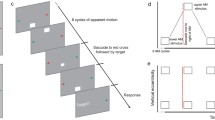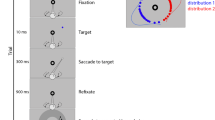Abstract
In the natural world, the brain must handle inherent delays in visual processing. This is a problem particularly during dynamic tasks. A possible solution to visuo-motor delays is prediction of a future state of the environment based on the current state and properties of the environment learned from experience. Prediction is well known to occur in both saccades and pursuit movements and is likely to depend on some kind of internal visual model as the basis for this prediction. However, most evidence comes from controlled laboratory studies using simple paradigms. In this study, we examine eye movements made in the context of demanding natural behavior, while playing squash. We show that prediction is a pervasive component of gaze behavior in this context. We show in addition that these predictive movements are extraordinarily precise and operate continuously in time across multiple trajectories and multiple movements. This suggests that prediction is based on complex dynamic visual models of the way that balls move, accumulated over extensive experience. Since eye, head, arm, and body movements all co-occur, it seems likely that a common internal model of predicted visual state is shared by different effectors to allow flexible coordination patterns. It is generally agreed that internal models are responsible for predicting future sensory state for control of body movements. The present work suggests that model-based prediction is likely to be a pervasive component in natural gaze control as well.








Similar content being viewed by others
References
Abernethy B (1990) Expertise, visual search, and information pick-up in squash. Perception 19:63–77
Aivar P, Hayhoe M, Mruczek R (2005) Role of spatial memory in saccadic targeting in natural tasks. J Vis 5:177–193
Assad JA, Maunsell JH (1995) Neuronal correlates of inferred motion in primate posterior parietal cortex. Nature 373(6514):518–521
Babcock JS, Pelz JB (2004) Building a lightweight eyetracking headgear. In: ACM SIGCHI eye tracking research & applications symposium, pp 109–114
Bahill AT, LaRitz T (1984) Why can’t batters keep their eye on the ball? Am Sci 72:249–253
Bahill AT, Baldwin DG, Venkateswaran J (2005) Predicting a baseball’s path. Am Sci 93:218–225
Barborica A, Ferrera VP (2003) Estimating invisible target speed from neuronal activity in monkey frontal eye field. Nat Neurosci 6:66–74
Barnes G, Collins C (2008) Evidence for a link between the extra-retinal component of random-onset pursuit and the anticipatory pursuit of predictable object motion. J Neurophysiol 100:1135–1146
Battaglia PW, Schrater P (2007) Humans trade off viewing time and movement duration to improve visuomotor accuracy in a fast reaching task. J Neurosci 27(26):6984–6994
Battaglia PW, Schrater P, Kersten D (2005) Auxiliary object knowledge influences visually-guided interception behavior. In: Proceedings of 2nd symposium APGV, pp 145–152
Becker W, Fuchs A (1985) Prediction in the oculomotor system: smooth pursuit during the transient disappearance of a visual target. Exp Brain Res 57:562–575
Blakemore SJ, Frith CD, Wolpert DW (2001) The cerebellum is involved in predicting the sensory consequences of action. Neuroreport 12(9):1879–1884
Brouwer A, Knill DC (2007) The role of memory in visually guided reaching. J Vis 7(5):6 (1–12)
Chen-Harris H, Joiner WM, Ethier V, Zee DS, Shadmehr R (2008) Adaptive control of saccades via internal feedback. J Neurosci 28(11):2804–2813
Churchland M, Chou I, Lisberger S (2003) Evidence for object permanence in the smooth pursuit movements of monkeys. J Neurophysiol 90:2205–2218
Collins C, Barnes GR (1999) Independent control of head and gaze movements during head-free pursuit in humans. J Physiol 515.1:299–314
Ferrera V, Barborica A (2010) Internally generated error signals in monkey frontal eye field during an inferred motion task. J Neurosci 30(35):11612–11623
Findlay JM (1981) Spatial and temporal factors in the predictive generation of saccadic eye movements. Vision Res 21(3):347–354
Flanagan J, Wing A (1997) The role of internal models in motion planning and control: evidence from grip force adjustments during movements of hand-held loads. J Neurosci 17:1519–1528
Fukushima K, Akao T, Shichinohe N, Nitta T, Kurkin S, Fukushima J (2008) Predictive signals in the pursuit area of the monkey frontal eye fields. Prog Brain Res 171:433–440
Fukushima K, Kasahara S, Akao T, Kurkin S, Fukushima J, Peterson B (2009) Eye-pursuit and reafferent head movement signals carried by pursuit neurons in the caudal part of the frontal eye fields during head-free pursuit. Cereb Cortex 19:263–275
Hayhoe M (2009) Visual memory in motor planning and action. In: Brockmole J (ed) Memory for the visual world. Psychology Press, UK, pp 117–139
Hayhoe M, Ballard D (2005) Eye movements in natural behavior. Trends Cogn Sci 9(4):188–193
Hayhoe M, Mennie N, Sullivan B, Gorgos K (2005) The role of internal models and prediction in catching balls. In: Proceedings of AAAI fall symposium series
Isotalo E, Lasker AG, Zee DS (2005) Cognitive influences on predictive saccadic tracking. Exp Brain Res 165:461–469
Itti L, Koch C (2001) Computational modeling of visual attention. Nat Rev Neurosci 2:194–203
Johansson RS (1996) Sensory control of dextrous manipulation in humans. In: Wing A, Haggard P, Flanagan J (eds) Hand and brain: the neurophysiology and psychology of hand movements. Academic Press, San Diego, pp 381–414
Joiner W, Shelhamer M (2006) Pursuit and saccadic tracking exhibit a similar dependence on movement preparation time. Exp Brain Res 173:572–586
Jovancevic-Misic J, Hayhoe M (2009) Adaptive gaze control in natural environments. J Neurosci 29(19):6234–6238
Kawato M (1999) Internal models for motor control and trajectory planning. Curr Opin Neurobiol 9(6):718–727
Koerding K, Wolpert D (2004) Bayesian integration in sensorimotor learning. Nature 427:244–247
Koerding K, Wolpert D (2006) Bayesian decision theory in sensorimotor control. Trends Cogn Sci 10:319–326
Kowler E, Martins A, Pavel M (1984) The effect of expectations on slow oculomotor control- IV Anticipatory smooth eye movements depend on prior target motions. Vis Res 24:197–210
Krauzlis R (2005) The control of voluntary eye movements: new perspectives. Neuroscientist 11(2):124–137
Land M (2004) Eye movements in daily life. In: Chalupa L, Werner J (eds) The visual neurosciences, vol 2. MIT Press, Cambridge, pp 1357–1368
Land MF, Furneaux S (1997) The knowledge base of the oculomotor system. Philos Trans R Soc Lond B Biol Sci 352:1231–1239
Land MF, McLeod P (2000) From eye movements to actions: how batsmen hit the ball. Nat Neurosci 3:1340–1345
Lopez-Moliner J, Field DT, Wann JP (2007) Interceptive timing: prior knowledge matters. J Vis 7:1–8
Madelain L, Krauzlis RJ (2003) Effects of learning on smooth pursuit during transient disappearance of a visual target. J Neurophysiol 90:972–982
Mulliken G, Andersen R (2009) Forward modles and state estimation in parietal cortex. In: Gazzaniga MS (ed) The cognitive neurosciences IV. MIT Press, Cambridge, pp 599–611
Nyffeler T, Rivaud-Pechoux S, Wattiez N, Gaymard N (2008) Involvement of the supplementary eye field in oculomotor predictive behavior. J Cog Neurosci 20(9):1583–1594
Pierrot-Deseilligny Ch, Müri A, Nyffeler B, Milea D (2005) The role of the human dorsolateral prefrontal cortex in ocular motor behavior. Ann NY Acad Sci 1039:239–251
Saunders JA, Knill DC (2003) Humans use continuous visual feedback from the hand to control fast reaching movements. Exp Brain Res 152:341–352
Schlicht E, Schrater P (2007) Reach-to-grasp trajectories adjust for uncertainty in the location of visual targets. Exp Brain Res 182:47–57
Shadmehr R, Mussa-Ivaldi FA (1994) Adaptive representation of dynamics during learning of a motor task. J Neurosci 14:3208–3224
Shelhamer M, Joiner WM (2003) Saccades exhibit abrupt transition between reactive and predictive, predictive saccade sequence have long-term correlations. J Neurophysiol 90:2763–2769
Shichinohe N, Akao T, Kurkin S, Fukushima J, Kaneko C, Fukushima K (2009) Memory and decision making in the frontal cortex during visual motion processing for smooth pursuit eye movements. Neuron 62:717–732
Simo LS, Krisky CM, Sweeney JA (2005) Functional neuroanatomy of anticipatory behavior: dissociation between sensory-driven and memory-driven systems. Cereb Cortex 15:1982–1991
Sprague N, Ballard D, Robinson A (2007) Modeling embodied visual behaviors. ACM Trans Appl Percept 4(2):11
Tabata H, Muira K, Kawano K (2008) Trial-by-trial updating of the gain in preparation for smooth pursuit eye movement based on past experience in humans. J Neurophysiol 99:747–758
Tassinari H, Hudson TE, Landy MS (2006) Combining priors and noisy visual cues in a rapid pointing task. J Neurosci 26:10154–10163
Tresilian JR, Houseman JH (2005) Systematic variation in performance of an interceptive action with changes in the temporal constraints. Q J Exp Psychol 58A:447–466
Wolpert D (2007) Probabilistic models in human sensorimotor control. Hum Mov Sci 26:511–524
Wolpert D, Miall C, Kawato M (1998) Internal models in the cerebellum. Trends Cogn Sci 2:338–347
Xaio Q, Barborica A, Ferrera V (2007) Modulation of visual responses in macaque frontal eye field during covert tracking of invisible targets. Cereb Cortex 17(4):918–928
Zago M, Bosco G, Maffei V, Iosa M, Ivanenko Y, Lacquaniti F (2004) Internal models of target motion: expected dynamics overrides measured kinematics in timing manual interceptions. J Neurophysiol 91:1620–1634
Zago M, McIntyre J, Patrice Senot P, Lacquaniti F (2008) Internal models and prediction of visual gravitational motion. Vis Res 48:1532–1538
Zago M, McIntyre J, Patrice Senot P, Lacquaniti F (2009) Visuo-motor coordination and internal models for object interception. Exp Brain Res 192(4):571–604
Acknowledgments
This work was supported by NIH Grant EY05729. The authors wish to acknowledge the assistance in data collection of Jason Droll and also players Eric Hernady and Mithun Mukherjee, as well as Martin Heath and members of the University of Rochester Squash Team.
Author information
Authors and Affiliations
Corresponding author
Electronic supplementary material
Below is the link to the electronic supplementary material.
Supplementary material 1 (AVI 263 kb)
Supplementary material 2 (AVI 137 kb)
Supplementary material 3 (AVI 219 kb)
Rights and permissions
About this article
Cite this article
Hayhoe, M.M., McKinney, T., Chajka, K. et al. Predictive eye movements in natural vision. Exp Brain Res 217, 125–136 (2012). https://doi.org/10.1007/s00221-011-2979-2
Received:
Accepted:
Published:
Issue Date:
DOI: https://doi.org/10.1007/s00221-011-2979-2




